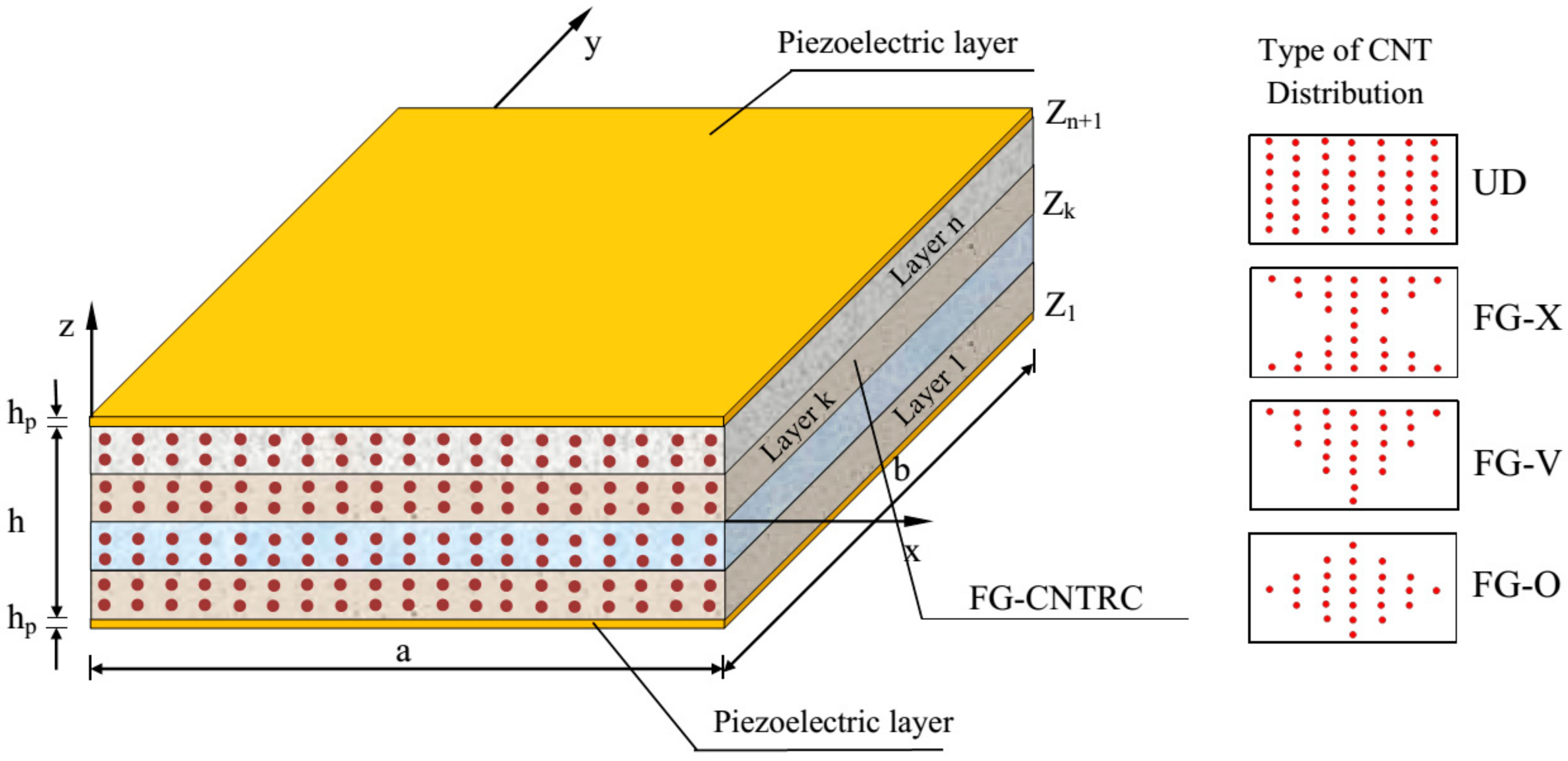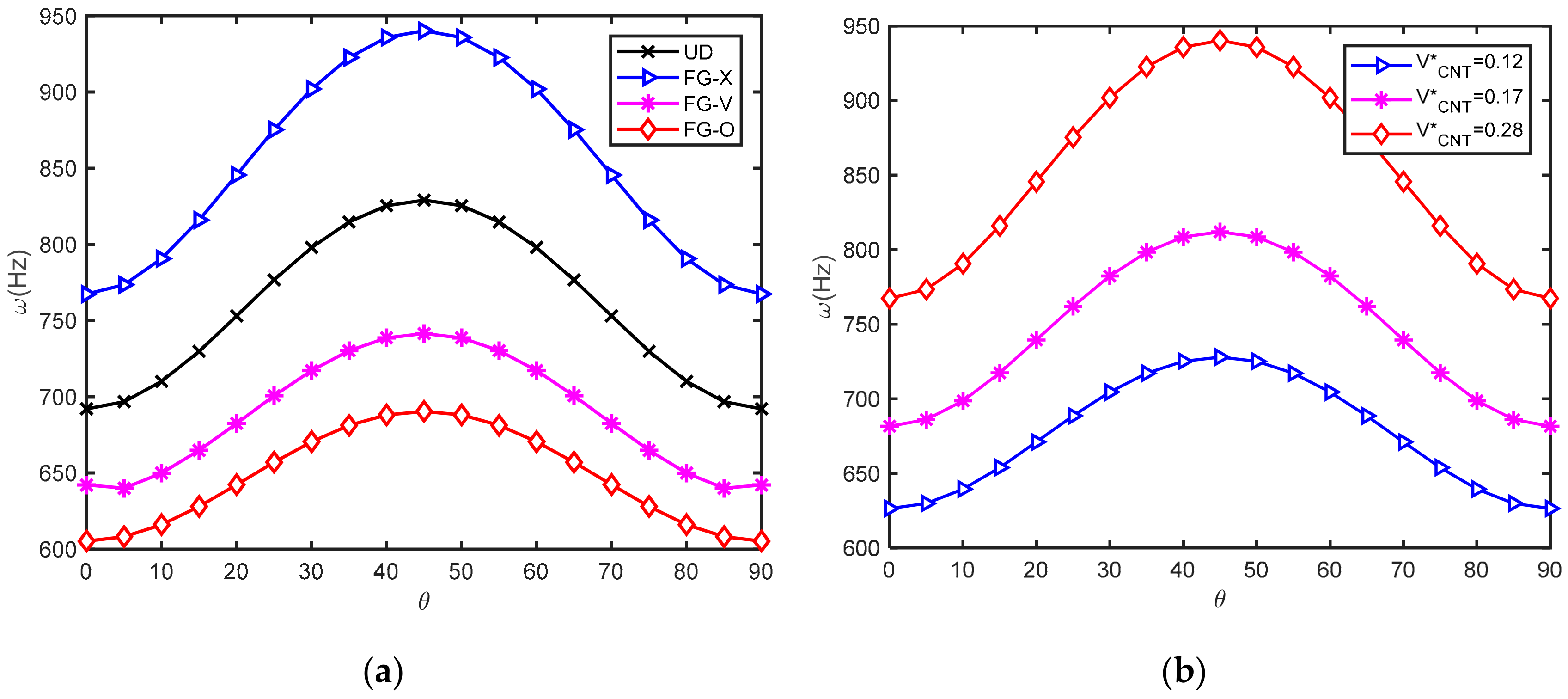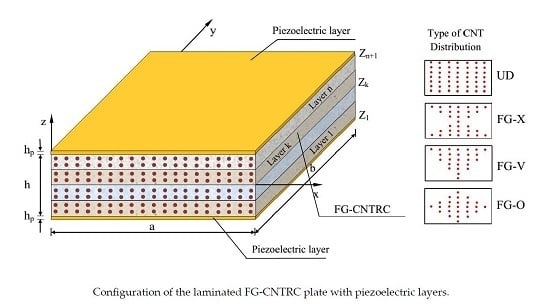1. Introduction
A novel class of functionally graded materials (FGM) titled functionally graded carbon nanotube-reinforced composite (FG-CNTRC) plates was first introduced by Shen [
1]. Shen’s study revealed that the distribution of CNT had a remarkable influence on the mechanical behaviors of the FG-CNTR plates. Since then, static, dynamic, and buckling behaviors of FG-CNTRC structures have been studied and reported in the literature. Alibeigloo and Liew [
2] studied the bending response of simply supported FG-CNTRC rectangular plate under thermo–mechanical loads by using the 3D theory of elasticity. Zhu et al. [
3] presented a finite element model to study bending and free vibration responses of thin-to-moderately thick FG-CNTRC plates using the first shear deformation plate theory (FSDT). Lei et al. [
4] gave the solution for static analysis of laminated FG-CNTRC plates using the element-free
kp-Ritz method. Huang et al. [
5] analyzed the bending and free vibration characteristics of antisymmetrically laminated FG-CNTRC plates using the FSDT and simple four-variable theory. The static, vibration and buckling responses of FG-CNTRC resting on elastic foundation were investigated by Wattanasakulpong [
6] and Nguyen et al. [
7]. Additionally, Shen et al. [
8] analyzed the buckling and post-buckling behaviors of symmetrically distributed CNT-reinforced composite plate, including thermal effects. Next, Shen et al. [
9] examined the buckling loads and post-buckling equilibrium paths of the CNTRC plates assuming properties of CNTs were temperature-dependent. Using a higher-order shear deformation plate theory (HSDT), the nonlinear free vibration behaviors of the FG-CNTRC plates with an elastic foundation in the thermal environment was investigated by Wang and Shen [
10]. That study used the perturbation technique to solve the nonlinear equations of motion. Mehar et al. [
11] investigated the static response of the FG-CNTRC doubly curved shell panel, in which the geometric nonlinear and thermal dependent properties of the individual constituents were considered. Using FSDT and piston theory in determining the aerodynamic pressure, Asadi et al. [
12] analyzed aeroelastic flutter of FG-CNTRC beams under axial compression and supersonic airflow. These authors continue to study the aero-thermoelastic behaviors of supersonic FG-CNTRC plates taking to account thermal effects in [
13].
There have been a limited number of studies related to electromechanical coupling analysis of laminated FG-CNTRC plates with surface-embedded or bonded piezoelectric layers. Using the 3D-theory, Alibeigloo investigated the bending behaviors of the piezoelectric FG-CNTRC (PFG-CNTRC) plates under the mechanical uniform load [
14], thermal load, and electric field [
2]. Rafiee et al. [
15] investigated initial geometrical imperfections in the large amplitude dynamic stability of PFG-CNTRC plates under the simultaneous effect of thermal and electrical loadings. Setoodeh et al. [
16] studied the free vibration characteristic of PFG-CNTRC spherical panels by differential quadrature method based on the HSDT. Using the Ritz method with Chebyshev polynomials, Kiani [
17] analyzed the free vibration of the PFG-CNTRC plates with opened and closed circuits electrical boundary conditions. In Kiani’s research, the electric potential in the piezoelectric layers was assumed to be linearly distributed through the thickness of the plate. Wu et al. [
18] presented a buckling analysis of an arbitrarily thick PFG-CNTRC plate subjected to in-plane compressive loads using unified formulation. Nguyen et al. [
19] used the extended isogeometric method with non-uniform rational B-spline and the HSDT to investigate the dynamic response of PFG-CNTRC plates. In the study of Selim et al. [
20], an element-free IMLS-Ritz model based on Reddy’s HSDT for the active vibration control of PFG-CNTRC plates was presented. Song et al. [
21] used velocity feedback and linear quadratic regulator LQR methods to study active vibration control of PFG-CNTRC cylindrical shells with bonded piezoelectric patches. Zhang et al. [
22] used a genetic algorithm to study shape control of FG-CNTRC rectangular plates bonded with piezoelectric patches acting as actuators and sensors.
HSDT [
23,
24,
25,
26,
27,
28] is often desirable for the design of composite structures since it yields more accurate results than the CPT (classical plate theory) and the FSDT. However, these HSDTs have computational costs because the equations of motions based on these HSDT are more. Therefore, simple HSDT must be developed. Recently, based on HSDT, Shimpi [
29] developed a new plate theory that has only two unknown displacements, in which the transverse shear stress variation across the thickness is parabolic and equals zero on free surfaces. After that, several researchers introduced a class of four-variable refined plate theory by adding two in-plane displacements and separating the transverse displacements into the bending component and shear component. Meiche et al. [
30] presented a new four-variable refined plate theory with hyperbolic shape function for buckling and vibration analysis of FGM sandwich plates. Thai and Vo [
31] developed a new sinusoidal shear deformation theory to analyze static and dynamic behaviors of FG plates. Then, another sinusoidal shear deformation theory was also presented by Thai and Kim [
32] to investigate the bending and free vibration response of FG plates. Daouadji et al. [
33] presented the static analysis of FG plates using a new higher-order shear deformation model.
In present work, a new plate theory with four unknown displacements is presented for free vibration analysis of FG-CNTR plates with two piezoelectric layers bonded at the free surfaces. The electric potential in piezoelectric layers is assumed to be quadratic through the thickness. Navier solution is applied to solve the governing equation of simply supported rectangular plates to obtain the frequencies of the smart FG-CNTRC plates with closed and open circuit electrical conditions. The accuracy of the proposed plate theory is indicated by comparing the obtained natural frequencies with existing results in the literature. Several examples are carried out to show the effects of volume fraction and distribution type of CNTs, the number of layers, CNT fiber orientation, and thickness of piezoelectric layers on the natural frequencies of hybrid plates.
2. Laminated PFG-CNTRC Plates
A hybrid laminated FG-CNTRC plate with integrated piezoelectric lamina at top and bottom surfaces is depicted in
Figure 1. Width, length, core thickness, and thickness of each piezoelectric layer of the plate are denoted by
a and
b,
h and
hp. Four types of CNT distribution across the thickness of each FG-CNT layer namely UD, FG-V, FG-O, and FG-X are also indicated in
Figure 1.
The CNT volume fractions for each FG-CNTRC lamina are assumed as follows [
3]:
where:
The effective elastic properties of each FG-CNTRC lamina can be written as follows [
3]:
where
and
,
are Young’s moduli and shear modulus of CNT and isotropic matrix, respectively;
, and
are called efficiency parameters.
and
are the volume fractions of CNT and of matrix, respectively; the Poisson ratio and mass density of CNT/matrix are denoted as
and
, respectively.
The linear constitutive relations for the FG-CNTRC core can be expressed as
where
are the transformed elastic coefficients related to elastic coefficients in material coordinates
[
34]:
The constitutive relations for a piezoelectric material can be expressed as [
35]
The elastic constants for the piezoelectric layer:
where
is the elastic constants matrix of the piezoelectric lamina,
is the dielectric permittivity matrix,
is the electromechanical coupling matrix,
is the electrical displacement, and
is the electric field in the piezoelectric lamina.
3. Kinematic Equations
According to the four-variable refined plate theory [
30,
31,
32,
33], the displacement components at an arbitrary point in the hybrid panel can be expressed as follows:
where
are the displacements of the corresponding point on the reference surface of the plate along
x and
y axis, respectively;
and
are the bending and shear components of the transverse displacement, respectively; the shape function
represents the distribution of the transverse shear stresses and strains along the thickness.
By supposing the shape function
satisfies the free transverse shear stress conditions on the free surfaces of the plates, a class of refined plate theory was developed by various researchers as shown in
Table 1:
In this study, a new shape function
is supposed as follows:
The linear strain-displacement relations are written as:
The variation of electric potential through the thickness of the piezoelectric lamina was proposed by Wu et al. [
36]:
where the unknowns
and
can be obtained by satisfying the specific electrical boundary condition. In this study, two cases of electrical boundary conditions are considered. For the closed circuit condition, both major surfaces of the piezoelectric lamina are circuited:
On the other hand, when one surface is kept at zero voltage and the other is electrically insulated, for the open circuit condition, the electrical boundary conditions are
In addition, from electric potential function, the electric field can be derived as
Substituting the expressions in Equations (13) and (8) into Equations (14) and (15) yields the electrical potential distribution for the closed circuit (C-circuit) as
and for open circuit (O-circuit) as
4. Equations of Motion
Hamilton’s principle is used herein to derive the governing differential equations of motion for the free vibration problem. Without external forces, the principle can be stated as [
37]
in which
δU is the variation of the strain energy of the plate and may be expressed as
where
N,
M, and
Q are stress resultants and defined by
and
δK is the variation of the kinetic energy of the plate and can be written as follows:
where mass moments
are defined by
Substituting Equation (12) into Equation (7), then the obtained results into Equation (21), and combine with the relations in Equation (16), the stress resultants are obtained as follows:
where
in which
and
Substituting the expressions of
δU and
δK from Equations (21)–(26) into Equation (20) and after some mathematical manipulations, we obtain the equations of motion of the plate as follow:
In addition, the electric potential in piezoelectric lamina must satisfy Maxwell’s equation:
5. Solution Procedures
In this study, two sets of simply supported boundary conditions (SSSS) are used to develop the Navier solutions for rectangular laminated plates and are shown in
Table 2.
To satisfy the above boundary conditions, the following expansion displacements
are chosen as in
Table 3:
where are unknown coefficients to be determined, , α= mπ/a, β = nπ/b.
In addition, the electrostatic potential can be expanded as follows:
Substituting Equation (35) and the displacements in
Table 3 into the equations of motion Equations (33) and (34), one obtains the analytical solution in the following matrix form:
where the matrix elements of Equation (36) are given in the
Appendix A.
7. Conclusions
In summary, this paper shows our contribution to the development of a new four-variable refined plate theory for free vibration analysis of laminated PFG-CNTRC plates. The comparison studies show that the present theory is not only accurate but also efficient in predicting the free vibration responses of the plates.
Our insight indicates that the natural frequency of the hybrid plates is strongly affected by the volume fraction of CNT and the distribution type of CNT in the matrix. FG-X CNTRC plate had the highest frequency, while the FG-O CNTRC plate had the smallest frequency regarding all inlet studied parameters. In addition, the lamination angles of CNT fiber and number of CNT lamina have a significant effect on the stiffness of the hybrid plate. Numerical results also revealed that the piezoelectric effect was more prominent in plates bonded with O-circuit piezoelectric lamina because, during vibration, the O-circuit converts electric potential to mechanical energy.
The present theory is accurate and efficient in solving free vibration behaviors of laminated FG-CNT reinforced composite plates with the piezoelectric layer and may be useful in the study of similar composite structures.











